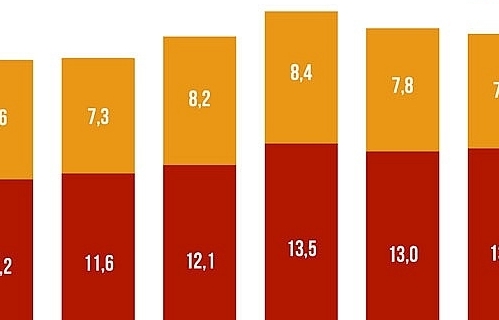Efforts to solve the shortage of high-quality human resources: Part 3: Vietnam needs a better-skilled workforce to elevate its economic development
 |
| Ms. Valentina Barcucci, labour economist, International Labour Organization in Vietnam |
In your opinion, what will be the biggest challenge for the sustainable development of the Vietnamese labour market?
Vietnam aims to become a high middle-income country by 2030, and will continue to move toward becoming a high-income country. The biggest challenge is that the strengths that have made Vietnam a lower middle-income country are not the factors pushing the country to a higher level.
The manufacturing industry with low added value, which accounts for a large proportion of the FDI sector, has become a tool for economic growth. However, a higher value-added industry with innovation, creativity, and a skilled workforce is necessary to ensure the economy grows further.
Employers now demand more skilled talent with more efficient operation of education and training systems and higher education systems.
Vietnam will need a new growth model to escape the risk of falling into the low-middle-income trap and achieve sustainable growth. It requires a modernized labour market. A labour market with graduates from a high-quality skill development system that is trusted by employers to invest time and resources.
It is a labour market with a mechanism of social protection for all the people and labour market institutions adjusted to changes in the labour market itself.
Vietnam is considered one of the low labour productivity countries in the region. What do you think about this statement, and what do you think Vietnam should do to improve labour productivity?
Labour productivity represents the total output produced by each unit of labour in a given period. In essence, this index looks at the economic value generated by the economy as a whole, and also looks at how many workers (whether paid workers or self-employed workers) the economy needs to produce that amount of value.
I mentioned above that one of Vietnam's biggest challenges is that it cannot be based on the same growth and development model as before to continue to develop its economy. Labour productivity is another example of this.
A key factor contributing to Vietnam's productivity growth over the past two decades has been the shift from farm to factory. Nearly a third of the workforce has moved from agriculture to industry and services over the past 20 years.
However, Vietnam is probably nearing the edge where this shift can continue to contribute to increases in productivity. Now it is important to find new solutions to increase productivity.
The size of Vietnamese enterprises is also a barrier to productivity growth. In many industries and services, such as manufacturing, there are only a few large enterprises with high efficiency, while the rest are relatively small ones.
There are many factors that help improve labour productivity, and some of them are related to the size of enterprises. For example, the accumulation of equipment, the improvement of production organization as well as facilities, and the creation of new technology are all factors that increase productivity.
Larger enterprises with better economic conditions are more likely to apply these factors. The skills of workers also play an important role, and small enterprises are unlikely to invest in the development of skills than large ones.
Finally, worker health and safety, good working conditions, giving workers a voice and the opportunity to receive training are important factors for improving productivity.
Vietnam's economy is gradually adapting to the "new normal". What advice do you have for Vietnamese workers and employers to seize the opportunities presented by the changing world of work?
My advice to employer and employee representatives is to participate together. They play an important role in formulating a future vision of work and realizing that vision.
A real-life example is skill development. The Vietnamese Government has made great efforts to reform the vocational education system and its governance.
While the Government has an overall responsibility to have a well-educated population and workforce for the benefit of the country's economy and society, enterprises, employers and employees also play an important role in this responsibility.
Employers are the ones connecting the demand of the labour market's skills. Their vacancies represent what is happening in the labour market in terms of skill demand. On the other hand, worker representation will play a role in ensuring that skill development not only prepares workers for a particular job in a given enterprise, but also provides an opportunity to access reasonable work. Each of these three objects has a role and responsibility to perform their roles in skill development.
Thank you, Madam!
Related News

Increasing consumption demand, steel enterprises face many opportunities
11:08 | 23/12/2024 Import-Export

Agricultural, forestry and fishery exports “reach the target” early
15:20 | 19/12/2024 Import-Export

Border gate planning: Issues for Lang Son
10:02 | 17/12/2024 Headlines

Seafood exports increase competitiveness through quality
10:24 | 09/12/2024 Import-Export
Latest News

UK a niche market for Vietnamese speciality coffee
14:11 | 23/12/2024 Import-Export

Vietnam-US trade thrives on effective mechanisms: trade counsellor
14:08 | 23/12/2024 Import-Export

Opening of overseas markets boosts coconut exports
13:59 | 23/12/2024 Import-Export

VN faced with increasing trade defence investigations on rising protectionism
18:58 | 22/12/2024 Import-Export
More News

Việt Nam expects to officially export passion fruit to the US next year
18:55 | 22/12/2024 Import-Export

UK’s carbon tax to affect VN exports
18:51 | 22/12/2024 Import-Export

Removing obstacles in granting certificates of exploited aquatic products
13:56 | 22/12/2024 Import-Export

Promoting agricultural exports to the Japanese market
13:55 | 22/12/2024 Import-Export

Agricultural exports in 2024 to exceed 60 billion USD?
13:53 | 22/12/2024 Import-Export

Seafood exports expected to exceed $10 billion in 2025: expert
20:28 | 21/12/2024 Import-Export

Top 10 Reputable Animal Feed Companies in 2024: Efforts to survive the challenges of nature
18:30 | 21/12/2024 Import-Export

Vietnam's import-export surges 15.3%
09:44 | 20/12/2024 Import-Export

More Vietnamese firms interested in Saudi Arabia: Ambassador
09:43 | 20/12/2024 Import-Export
Your care

UK a niche market for Vietnamese speciality coffee
14:11 | 23/12/2024 Import-Export

Vietnam-US trade thrives on effective mechanisms: trade counsellor
14:08 | 23/12/2024 Import-Export

Opening of overseas markets boosts coconut exports
13:59 | 23/12/2024 Import-Export

Increasing consumption demand, steel enterprises face many opportunities
11:08 | 23/12/2024 Import-Export

VN faced with increasing trade defence investigations on rising protectionism
18:58 | 22/12/2024 Import-Export




